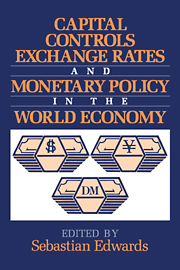Book contents
- Frontmatter
- Contents
- List of contributors
- Introduction
- Part I Monetary policy and stabilization in open economies
- 1 Stabilization and liberalization policies in semi-open economies
- 2 Monetary regime choice for a semi-open country
- 3 Capital account liberalization: bringing policy in line with reality
- Part II Capital mobility and macroeconomic policy in Europe
- Part III Capital controls and macroeconomic policy in the Asia-Pacific region
- Part IV Capital mobility and exchange rates in Latin America
- Index
3 - Capital account liberalization: bringing policy in line with reality
Published online by Cambridge University Press: 16 October 2009
- Frontmatter
- Contents
- List of contributors
- Introduction
- Part I Monetary policy and stabilization in open economies
- 1 Stabilization and liberalization policies in semi-open economies
- 2 Monetary regime choice for a semi-open country
- 3 Capital account liberalization: bringing policy in line with reality
- Part II Capital mobility and macroeconomic policy in Europe
- Part III Capital controls and macroeconomic policy in the Asia-Pacific region
- Part IV Capital mobility and exchange rates in Latin America
- Index
Summary
Introduction
An important feature of the international financial code of conduct established in the Bretton Woods Conference toward the end of World War II was the acceptability of controls and restrictions on international capital flows. In particular, the Articles of Agreement of the International Monetary Fund, which contain such code of conduct, prescribe that:
Members may exercise such controls as are necessary to regulate international capital movements, but no member may exercise these controls in a manner which restricts payments for current transactions or which will unduly delay transfers of funds in settlements of commitments, except as provided in Article VIII, Section 3(b) and in Article XIV, Section 2. (Article VI, Section 3).
There was logic at the time of the drafting and acceptance of the Articles of Agreement in including this feature into the rules of the game that were to govern international transactions. The flow of trade, current and capital account exchanges among countries, had been disrupted prior to and during the hostilities; capital movements had not become yet a pre- dominant force in the international transaction network; and for purposes of reconstruction and the resumption of normality in the world economy, encouragement of international trade and exchange became essential. Consequently, attention concentrated on the liberalization of trade and other current account flows, an aim that became enshrined in the Articles of Agreement of the International Monetary Fund.
- Type
- Chapter
- Information
- Publisher: Cambridge University PressPrint publication year: 1995
- 1
- Cited by



